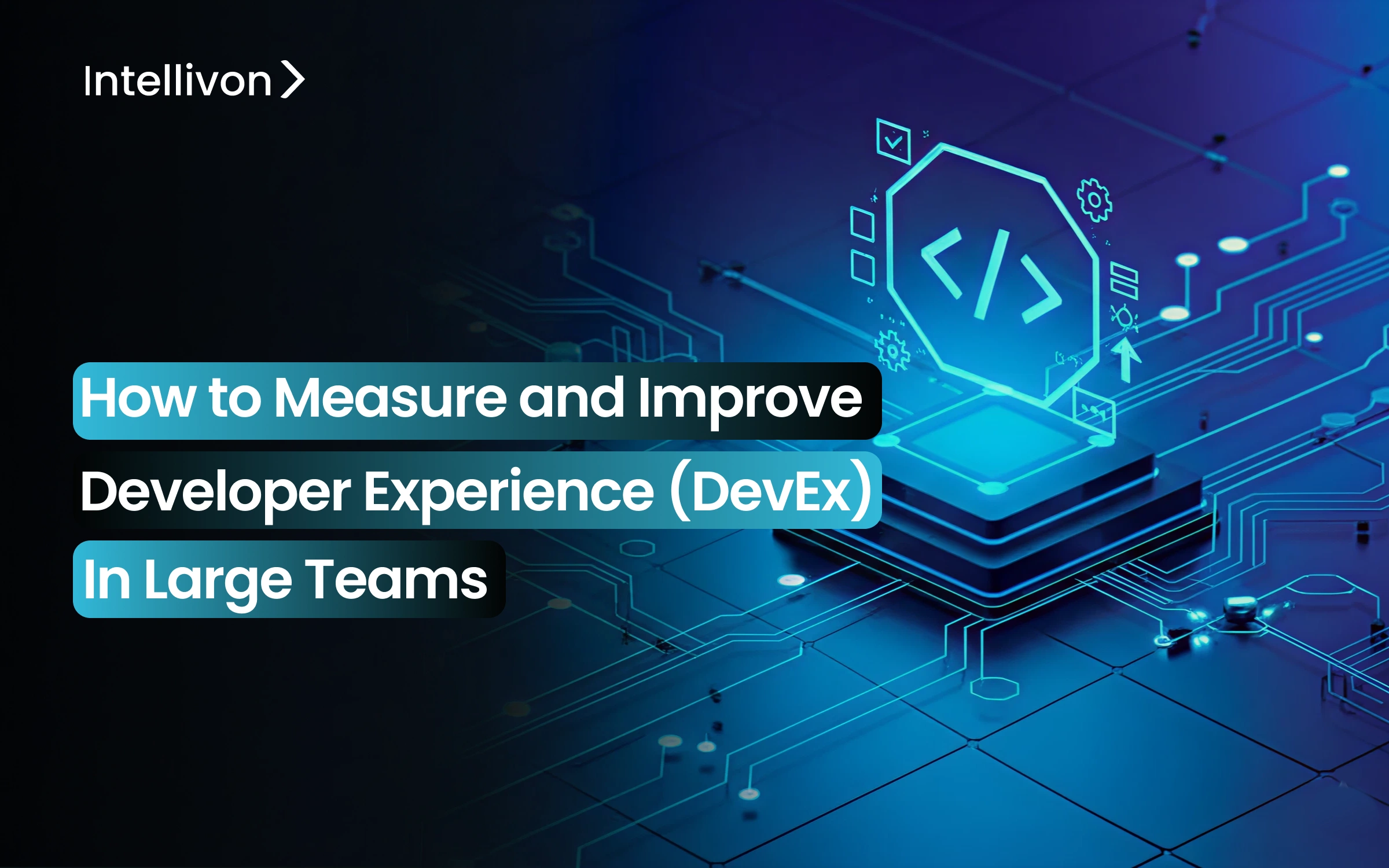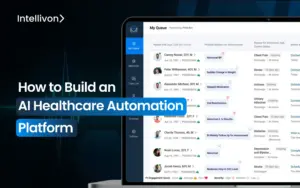In today’s software development landscape, organizations are recognizing that improving developer experience (DevEx) is important for staying competitive and achieving engineering excellence. With 76% of organizations planning to invest more in developer experience within the next year, there is an understanding that such investments bring real benefits. Each one-point gain in developer experience has been linked to saving 13 minutes of time per developer each week. This adds up to significant productivity gains across large engineering teams, where small inefficiencies can multiply across hundreds or thousands of developers.
The key to measuring and improving DevEx is to focus on developers and their experiences in delivering software. This is what we do at Intellivon, where we create custom platforms for enterprises to help them improve DevEx management. In this blog, we will explore ways to measure and enhance DevEx and discuss how we build and deliver these strong platforms for enterprises.
Understanding the DevEx Marketplace
The global software development tools market is valued at $6.41 billion in 2025. It is expected to reach $13.70 billion by 2030, growing at a 16.4% CAGR. This growth drives the expansion of the developer experience (DevEx) market. Enterprises now focus more on developer productivity, retention, and faster digital transformation.
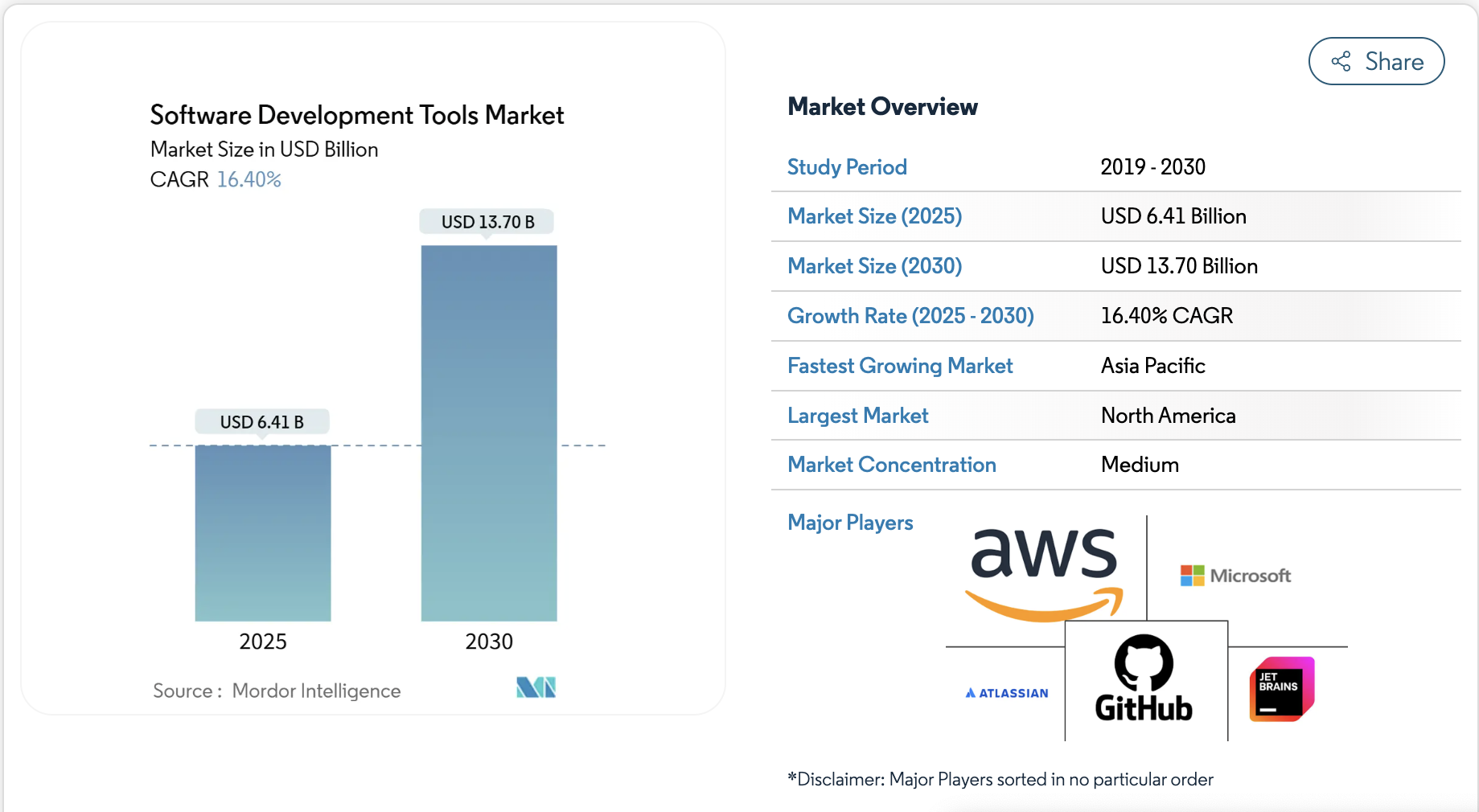
Key DevEx Market Trends:
- AI-powered developer tools are everywhere. In 2025, 92% of developers use AI tools. These tools boost productivity by 25%.
- Low-code and no-code platforms are booming. They are projected to hit $65 billion by 2027. By 2025, 70% of enterprise apps will use low-code/no-code solutions.
- More organizations invest in DevEx.Around 76% of companies plan to increase their DevEx budget next year. They see a direct link between investment and higher developer satisfaction and output.
- High-quality DevEx drives real results. It improves feature delivery flow by 31%, productivity by 42%, and innovation by 50%.
- Stronger DevEx equals higher revenue and retention. Teams with good DevEx show 60% greater revenue growth. They are 20% more likely to keep their developers.
Enterprise Adoption and Platform Focus:
- Most developer time isn’t productive. Only 40% of their time is spent building code. Poor DevEx drives talent loss.
- DevEx includes all engineering roles. It covers infrastructure, data, security, and quality engineers. Leading platforms offer business process automation and intuitive interfaces.
- Successful DevEx breaks down silos. It empowers domain experts by speeding up feature delivery and removing bottlenecks.
Developer Sentiment and How to Measure DevEx:
- Many developers accept productivity assessments. 42% feel comfortable if the process is transparent.
- Yet, tool satisfaction is rarely measured. 55% of organizations don’t track this, creating a blind spot.
- Tech leads play a key role. 67% of tech leads and 51% of developers see leaders as key DevEx drivers.
- Old productivity metrics are outdated. Metrics like lines of code don’t reflect real work. Instead, measuring collaboration quality and developer satisfaction is more useful.
Why Enterprises Should Prioritize DevEx for Their Teams
Developer Experience (DevEx) is how developers interact with the tools, processes, and environment in their organization. In large enterprise teams, it is more than having the latest software or a nice workspace. DevEx includes how fast developers get feedback on their code, how simple it is to understand complex systems, and how well they can focus without distractions. A good DevEx helps developers work faster, write cleaner code, and feel more satisfied in their jobs. As a result, enterprises get higher productivity, better software quality, and lower employee turnover.
Many organizations overlook a key factor that affects all these outcomes: DevEx. Ignoring DevEx creates serious risks. It slows productivity, opens security gaps, and hurts overall business performance.
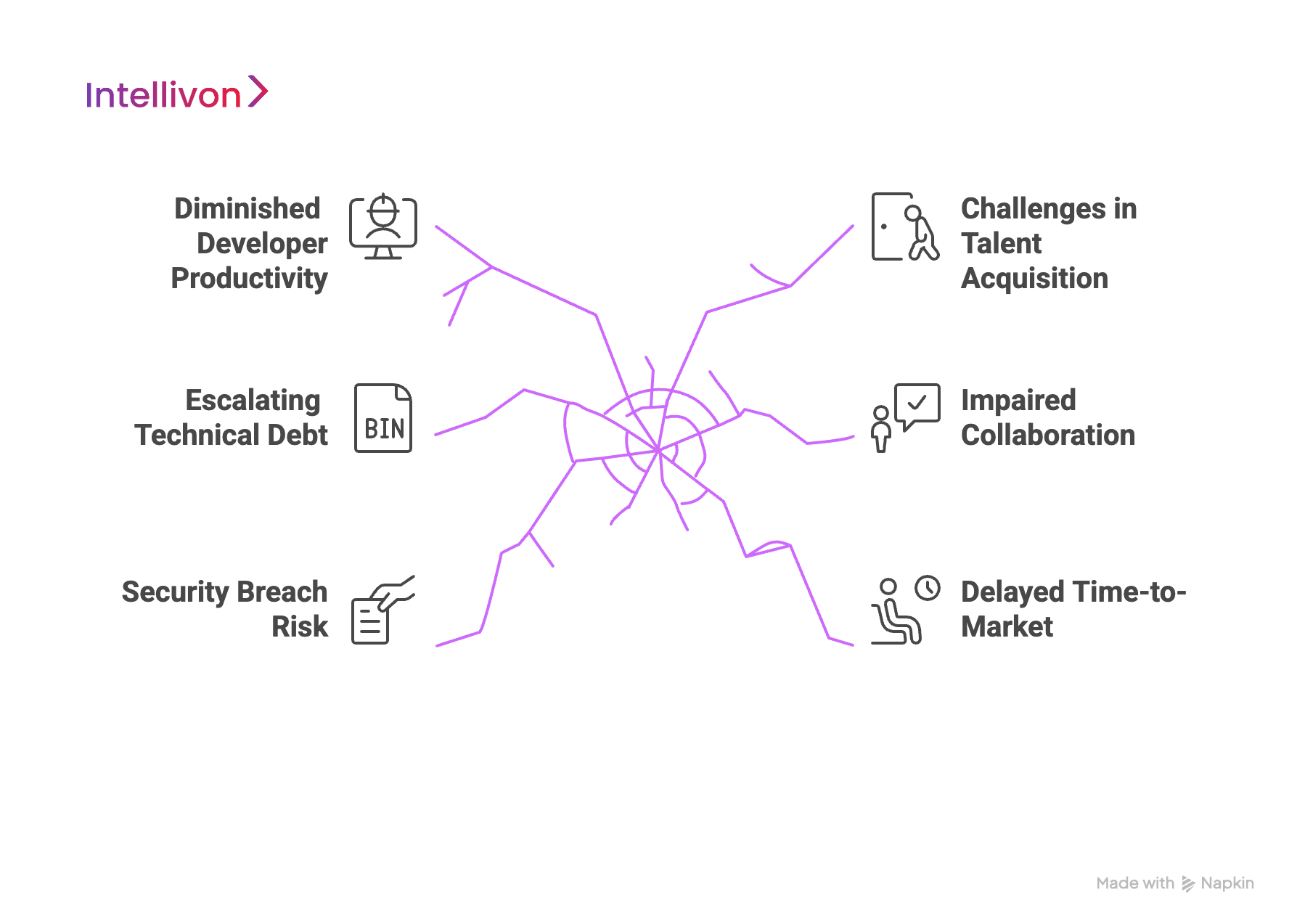
1. Security Breach Risk
A major consequence of poor DevEx is an increased risk of security breaches. Even when strong security policies are in place, many companies still suffer breaches caused by insecure coding practices.
In fact, a recent study found that 74% of companies experienced at least one breach in the past year due to insecure code. Therefore, enterprises must create an environment where developers can follow best practices, use secure coding tools, and get ongoing training. This reduces vulnerabilities and strengthens security.
2. Escalating Technical Debt
Without a clear focus on DevEx, technical debt accumulates quickly. Research shows that low-quality code contains 15 times more defects than high-quality code. Worse, fixing these defects takes 124% more time on average.
As a result, companies face rising maintenance costs and slower development cycles. This not only impacts budgets but also delays new features and improvements. Consequently, customer satisfaction drops, and businesses lose their competitive edge.
3. Diminished Developer Productivity
Developer productivity and morale suffer when tools are inefficient and workflows are convoluted. When developers feel unsupported, their motivation declines. This leads to lower-quality code, project delays, and a higher risk of failure.
In contrast, a strong DevEx strategy provides efficient tools, clear processes, and a supportive environment. These help developers stay productive, engaged, and focused.
4. Challenges in Talent Acquisition
Hiring and retaining top talent becomes harder without a good DevEx strategy. In today’s competitive job market, skilled developers seek workplaces that prioritize their experience. Studies show that companies with strong DevEx are 20% more likely to retain their developers.
On the other hand, organizations that neglect this area face high turnover, increased hiring costs, and a loss of institutional knowledge. By investing in DevEx, companies build a stable, motivated development team.
5. Impaired Collaboration
Poor DevEx impacts collaboration and innovation. Fragmented tools and unclear workflows create isolated teams. This leads to misaligned goals and communication breakdowns. As a result, innovation stalls, and projects move slowly.
However, when enterprises provide a cohesive developer environment, teams can easily share knowledge and experiment with new ideas. This breaks down silos and encourages continuous improvement, which drives long-term innovation and growth.
6. Delayed Time-to-Market
Weak DevEx slows time-to-market. Inefficient processes and inadequate tooling make it harder to deliver software on time. Enterprises that do not prioritize DevEx struggle to meet market demands. They miss opportunities and lose market share.
By contrast, empowering developers with intuitive tools and streamlined workflows accelerates software delivery. This helps businesses respond quickly to customer needs and maintain a competitive edge.
Prioritizing DevEx allows enterprises to reduce these risks, enhance developer satisfaction, and speed up time-to-market.
Benefits of Enhancing DevEx in Large Enterprise Teams
In large enterprises, the decision to prioritize DevEx goes beyond developer satisfaction. It is a strategic move that impacts organizational performance, innovation, and competitiveness. Neglecting DevEx leads to missed opportunities and increased risks. In contrast, investing in it delivers clear benefits that affect the entire business.
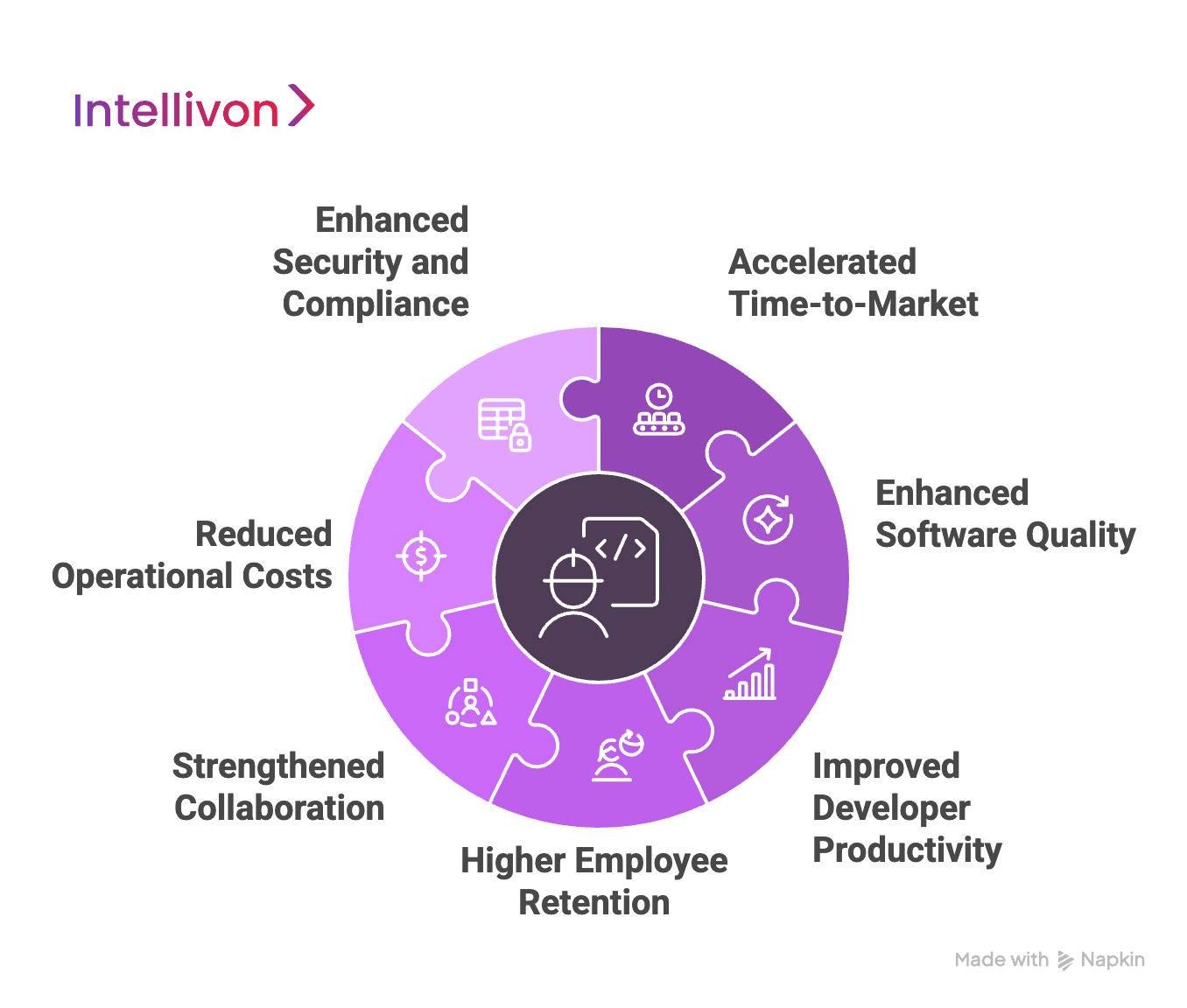
1. Accelerated Time-to-Market
Streamlined workflows and less friction enable development teams to deliver features and updates faster. Enterprises that invest in DevEx often experience quicker time-to-market. This allows them to respond rapidly to market demands and gain a competitive edge.
For example, organizations that optimize their developer environments report significantly shorter development cycles, leading to faster delivery of products and services.
2. Enhanced Software Quality
A well-designed DevEx framework creates an environment where developers focus on writing clean, maintainable code. By providing the right tools and processes, enterprises reduce bugs and technical debt.
Studies show that companies with strong DevEx practices see fewer customer-reported product defects and higher customer satisfaction ratings. This highlights the direct impact of a good developer experience on software quality.
3. Improved Developer Productivity
Investing in DevEx leads to higher productivity by reducing time spent on repetitive tasks and troubleshooting. Developers with intuitive tools and efficient processes can focus on value-added work.
As a result, output and innovation increase. Research indicates that organizations with strong DevEx see noticeable gains in developer productivity, contributing to broader business success.
4. Higher Employee Retention
A positive developer experience improves job satisfaction and employee retention. Developers are more likely to stay at companies that invest in their growth and well-being. In addition, a reputation for supporting developers attracts top talent. Enterprises with good DevEx practices gain access to a broader pool of skilled professionals, helping them stay competitive.
5. Strengthened Collaboration
DevEx initiatives encourage collaboration by offering shared tools and platforms. These improve communication and knowledge sharing between teams. As a result, developers can exchange ideas more easily and solve complex problems together.
Enterprises that prioritize DevEx often report more innovative solutions and a dynamic approach to product development.
6. Reduced Operational Costs
Better DevEx reduces inefficiencies and streamlines development processes. This leads to fewer errors, less rework, and more efficient use of resources. Consequently, enterprises lower their operational costs.
Organizations that improve DevEx report significant savings in software delivery and maintenance, demonstrating the financial benefits of investing in developer experience.
7. Enhanced Security and Compliance
A strong DevEx framework integrates security and compliance from the start. It ensures applications are built following security best practices. This proactive approach lowers the risk of vulnerabilities and keeps the organization in line with regulatory requirements.
As a result, enterprises are better protected from potential breaches and compliance failures.
Enterprises that invest in DevEx position themselves for sustained success in an increasingly fast-paced and competitive digital world.
Developer Experience Dimensions: Feedback Loops, Cognitive Load, and Flow State
In large enterprise teams, DevEx covers the complex interaction of many factors that shape how developers work. Understanding and improving these factors is key to boosting productivity, satisfaction, and overall performance.
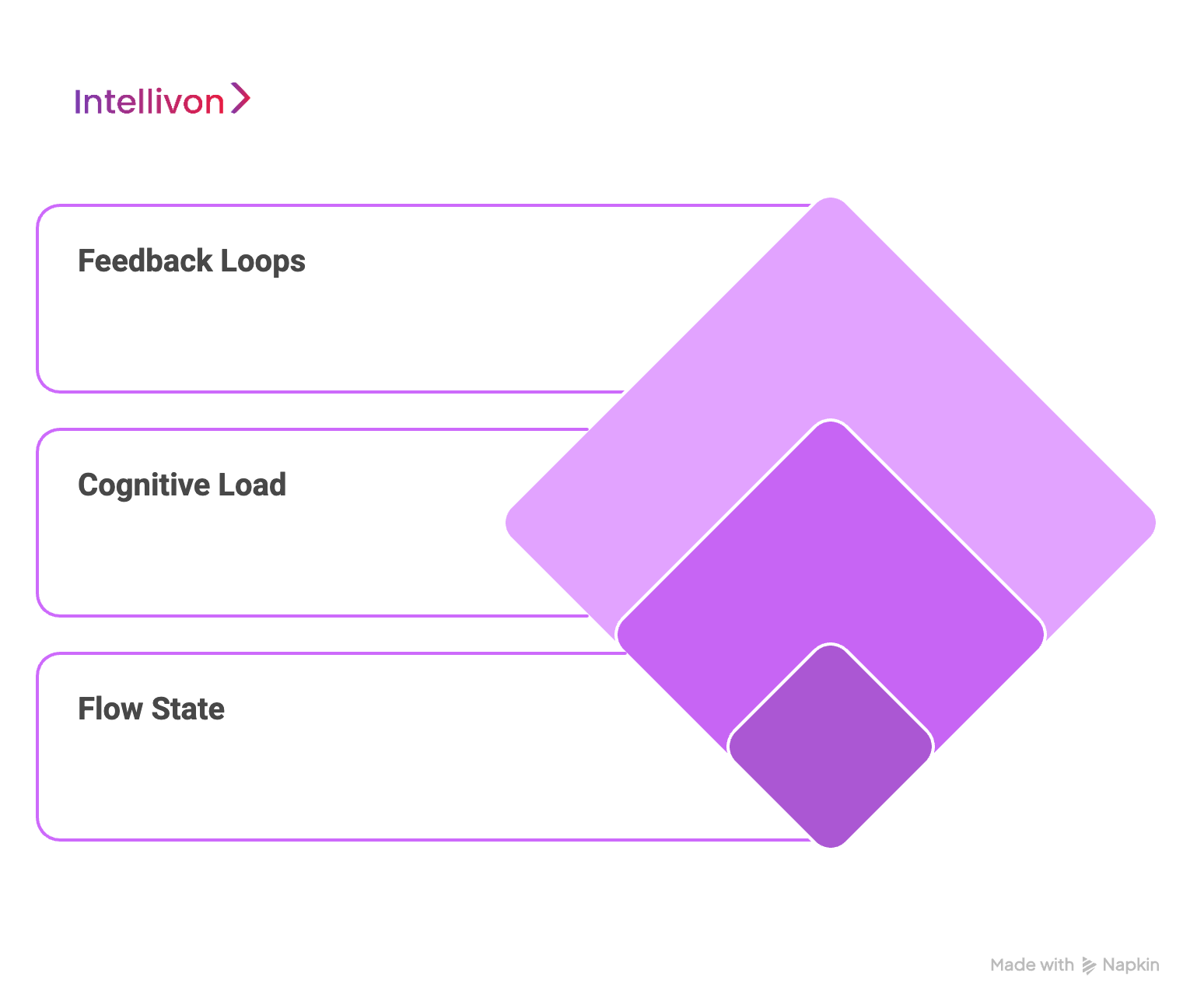
1. Feedback Loops
Feedback loops refer to the speed and quality of responses developers get when they take action. In software development, feedback loops happen in several ways.
First, there is build and test feedback, which shows how long it takes to compile code and run tests. Next, code review feedback measures the time between submitting code and receiving comments. Then comes deployment feedback, which tracks how fast code gets deployed and monitored in production.
Shortening feedback loops is essential. Research shows that organizations with faster feedback loops are more likely to exceed performance goals. They can spot and fix problems early, improving software quality and developer satisfaction.
2. Cognitive Load
Cognitive load is the mental effort needed to do tasks. In development, high cognitive load comes from several sources.
One is complex codebases, which are code that is hard to understand or poorly documented. Another issue is inconsistent tooling, which occurs when tools and processes are not standardized. Frequent multitasking also adds to cognitive load, as developers switch between tasks and contexts.
High cognitive load leads to more errors, slower work, and burnout. By reducing unnecessary complexity and offering clear documentation and standardized tools, enterprises help developers work more efficiently. This leads to faster and higher-quality development.
3. Flow State
Flow state is when developers are fully immersed in their work. In this state, they are highly productive and satisfied.
Achieving flow state requires a few key factors. First, there must be minimal interruptions, which include fewer unnecessary meetings and notifications. Second, task alignment ensures tasks match developers’ skills and interests. Third, giving developers autonomy over their processes helps them stay engaged.
Organizations that foster flow state see more innovation and higher job satisfaction among developers. A well-designed environment supports deep work and cuts disruptions, which helps developers reach their peak performance.
4. How These Dimensions Interact
Feedback loops, cognitive load, and flow state don’t exist in isolation. They interact closely.
For example, slow feedback loops increase cognitive load. Developers wait longer to know if their work is correct. This makes it harder to get into or stay in a flow state. On the other hand, fast feedback loops reduce cognitive load and make flow state easier to achieve.
In large enterprises, complexity is often unavoidable. That’s why understanding and improving these three dimensions is so important. By focusing on faster feedback, lower cognitive load, and enabling flow, organizations improve Developer Experience.
This leads to more productive developers, greater innovation, and higher job satisfaction. It also aligns with bigger business goals, like faster time-to-market, better software quality, and a more engaged workforce.
How We Spot Weak DevEx for Large Enterprise Teams
In large enterprises, DevEx is often hidden in plain sight. Teams may appear to work fine, yet small inefficiencies, frustrations, and bottlenecks build up over time. This leads to lower productivity, higher turnover, and slower innovation. Spotting weak DevEx requires a systematic, multidimensional approach. At Intellivon, we combine qualitative insights with quantitative metrics to uncover hidden challenges and optimize developer environments.
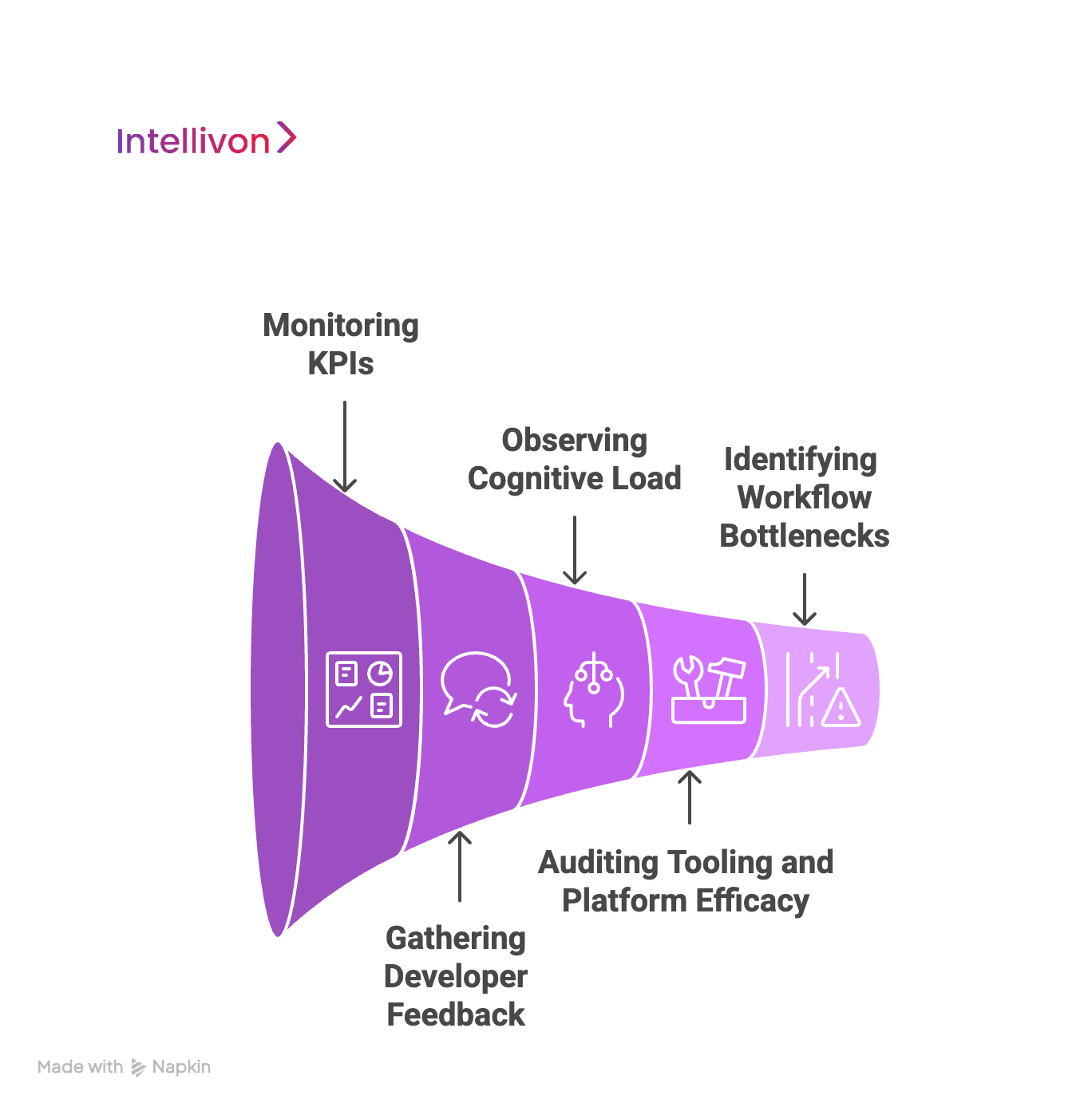
1. Monitoring KPIs
At Intellivon, we track key KPIs that reveal weak DevEx. For example, long lead times and slow deployments suggest bottlenecks in CI/CD pipelines or approval processes. High change failure rates point to friction in processes or poor tooling.
Extended pull request review times indicate workflow inefficiencies or overloaded teams. Low developer velocity, seen as fewer features delivered or slow iterations, signals obstacles in the developer environment.
By closely monitoring these KPIs, Intellivon helps enterprises pinpoint where developers face unnecessary delays or difficulties.
2. Gathering Developer Feedback
We believe metrics alone don’t tell the full story. That’s why Intellivon emphasizes collecting developers’ perspectives. Our process includes structured surveys and Developer Net Promoter Scores (DevNPS) to capture feedback about tool usability, workflow satisfaction, and process bottlenecks.
We also conduct interviews and focus groups to identify specific frustrations, repetitive tasks, or areas where developers feel unsupported. Additionally, we analyze recurring internal support tickets to reveal systemic issues with tools, onboarding, or documentation.
This qualitative approach ensures hidden frustrations are surfaced and addressed effectively.
3. Observing Cognitive Load
Intellivon understands that high cognitive load often signals poor DevEx. Developers struggle when they juggle multiple tools with inconsistent interfaces.
They face complex codebases with insufficient documentation. Frequent context switching occurs because of unclear priorities or constant interruptions.
By carefully mapping developer workflows, we identify sources of mental strain. This allows us to recommend actionable solutions that reduce friction and improve focus.
4. Auditing Tooling and Platform Efficacy
Inefficient or fragmented tools are a key cause of weak DevEx. Intellivon conducts thorough audits of existing tooling and platform integrations. We look for tool fragmentation, where multiple incompatible tools slow development.
Then we assess integration gaps in CI/CD pipelines, monitoring dashboards, and collaboration tools. Additionally, we also identify repetitive tasks that can be automated for better efficiency.
Our audits help enterprises spot gaps and unlock opportunities to improve their developer experience.
5. Identifying Workflow Bottlenecks
Large teams often develop informal workarounds to cope with inefficient processes. At Intellivon, we observe how work flows in practice. This reveals redundant steps in approvals or deployments, misaligned responsibilities between teams, and delays in feedback loops, testing, or bug resolution.
By addressing these bottlenecks, we help enterprises improve developer workflows and accelerate delivery.
At Intellivon, we know that spotting weak DevEx in large enterprise teams requires a holistic view. By combining KPI tracking, developer feedback, cognitive load analysis, tooling audits, and workflow observation, we identify hidden problems early. Our targeted solutions improve productivity, reduce turnover, and foster innovation. Investing in DevEx is a strategic advantage for thriving in the digital age.
How to Measure DevEx in Large Enterprise Teams
Measuring DevEx is essential for large enterprises aiming to boost productivity, reduce friction, and improve software quality. Accurate measurement allows enterprises to uncover bottlenecks, prioritize improvements, and track progress over time.
1. DORA Metrics: The Foundation
The DevOps Research and Assessment (DORA) metrics are the industry standard for evaluating software delivery performance. These quantitative metrics provide a strong starting point to measure developer productivity and efficiency.
- Deployment Frequency measures how often code is released to production. High frequency indicates a smooth, low-friction workflow.
- Lead Time for Changes tracks the time from code commit to deployment. Short lead times show that developers can deliver features quickly.
- Change Failure Rate calculates the percentage of deployments that fail or need fixes. Lower rates indicate better code quality and more reliable processes.
- Mean Time to Recovery (MTTR) measures how quickly services are restored after a failure. Faster recovery reflects effective collaboration, monitoring, and tooling.
DORA metrics provide a clear, data-driven snapshot of developer performance. However, they capture only part of the overall experience. Enterprises must look beyond DORA to fully understand DevEx.
2. Measuring Beyond DORA
Large enterprises benefit from additional quantitative metrics that capture the nuances of developer experience.
- Pull Request (PR) Cycle Time: Tracks the time from PR submission to merge. Long cycles may indicate review bottlenecks.
- Build and Test Times: Measures the duration of builds and automated tests. Slow or failing builds increase frustration and cognitive load.
- Time Spent on Repetitive Tasks: Quantifies manual or redundant work, such as environment setup or deployments. Reducing this improves productivity.
- Error and Incident Rates by Tooling: Monitors how often developers encounter errors in IDEs, APIs, or deployment scripts. High rates point to pain points in the environment.
- Usage Analytics for Internal Tools: Tracks adoption, feature usage, and workflow patterns to reveal underutilized resources or improvement areas.
- Developer Onboarding Time: Measures how long it takes to onboard new developers effectively, highlighting inefficiencies in documentation, tooling, or processes.
These metrics help enterprises see the hidden friction and inefficiencies that affect day-to-day developer work.
3. Qualitative Measures
Quantitative metrics alone cannot capture the human side of DevEx. Qualitative insights show how developers feel and how workflows affect their productivity.
- Developer Satisfaction Surveys: Structured surveys assess satisfaction with tools, processes, and collaboration. Questions cover efficiency, frustration, and support levels.
- Developer Net Promoter Score (DevNPS): Measures developers’ willingness to recommend their work environment or tools, giving a high-level indicator of engagement.
- Focus Groups and Interviews: Conversations with developers uncover pain points, unmet needs, and hidden bottlenecks that metrics miss.
- Observation of Workflows: Shadowing developers or analyzing session logs highlights friction, context switching, or cognitive overload.
- Feedback Loops on Tools and Processes: Continuous input on new tools or process changes allows enterprises to iterate and improve the development experience.
4. Integrating Quantitative and Qualitative Measures
The most effective DevEx measurement combines data-driven insights with developer perspectives.
For example, DORA metrics might show slow deployment cycles. Qualitative feedback could reveal that delays stem from inefficient approvals or unclear documentation. Similarly, build time analytics may indicate delays, while interviews uncover frustrations with non-standardized environments or tool conflicts.
By triangulating these measures, enterprises gain a holistic understanding of DevEx, identifying both system-level issues and human factors that impact productivity and satisfaction.
5. Continuous Monitoring and Iteration
Measuring DevEx is not a one-time activity. Continuous monitoring helps enterprises:
- Track improvements over time.
- Spot emerging bottlenecks as teams expand or tools change.
- Adjust workflows, tooling, and platform designs proactively to maintain high developer satisfaction.
For large enterprise teams, a structured measurement framework that combines DORA metrics, extended quantitative metrics, and qualitative feedback provides a powerful foundation. This approach enhances Developer Experience, drives efficiency, and supports long-term innovation.
Proven Strategies for Improving DevEx for Large Enterprise Teams
Enhancing DevEx is a strategic priority for large enterprises. Inefficiencies, fragmented tools, and complex workflows can slow productivity and reduce satisfaction. Improving DevEx requires a comprehensive, multi-dimensional approach that addresses tooling, processes, culture, and feedback mechanisms. The following strategies have proven effective in driving higher developer satisfaction, efficiency, and innovation.
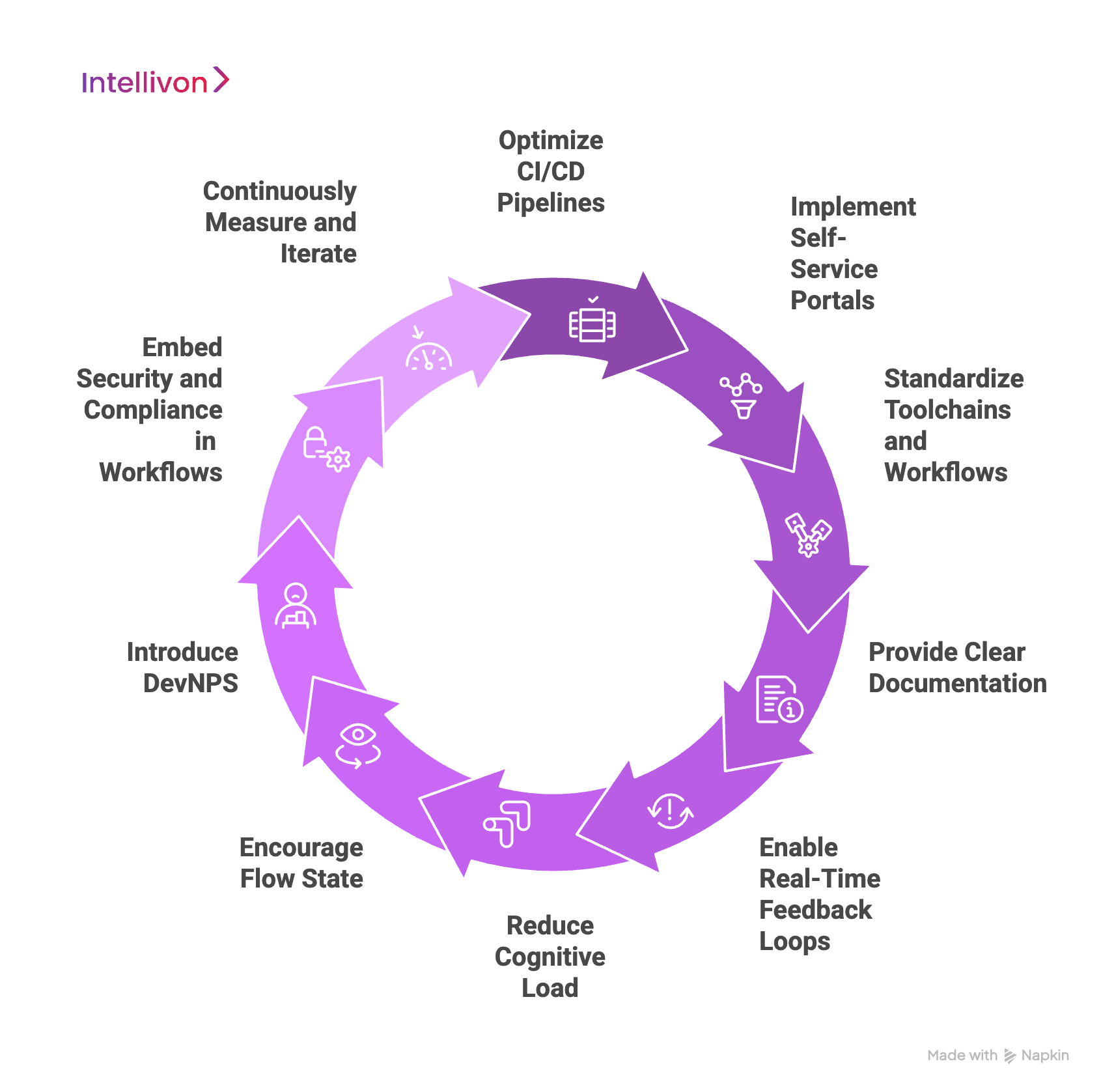
1. Optimize CI/CD Pipelines
Fast, reliable, and automated CI/CD pipelines reduce friction in software delivery. Enterprises should invest in optimizing build, test, and deployment processes to minimize wait times and errors. Streamlined pipelines let developers focus on coding and innovation rather than troubleshooting failures, improving both productivity and job satisfaction.
2. Implement Self-Service Developer Portals
Centralized self-service portals empower developers to provision environments, access shared services, and deploy applications independently. This autonomy reduces bottlenecks, accelerates delivery, and fosters a sense of ownership, which is critical in large, distributed teams.
3. Standardize Toolchains and Workflows
Inconsistent tools and workflows create confusion and cognitive load. Standardizing toolchains ensures everyone uses familiar interfaces, practices, and integrations. This reduces errors, speeds collaboration, and allows developers to focus on value-added work instead of learning multiple systems.
4. Provide Clear Documentation
Up-to-date documentation is essential for smooth development. This includes codebases, APIs, internal libraries, workflows, and compliance requirements. Clear documentation helps developers find information quickly, onboard new team members efficiently, and maintain high-quality output without repeated guidance.
5. Enable Real-Time Feedback Loops
Fast feedback on builds, code reviews, testing, and deployments keeps developers engaged and efficient. Real-time feedback allows quick error correction, learning from mistakes, and faster iteration. Enterprises implementing rapid feedback mechanisms see better code quality, quicker delivery, and happier teams.
6. Reduce Cognitive Load
High cognitive load from complex code, fragmented tools, and constant context switching slows productivity and causes burnout. Streamlining workflows, providing reusable templates, and simplifying environments help developers focus on problem-solving and creative tasks.
7. Encourage Flow State
Flow state, or deep focus, is where developers achieve peak productivity. Enterprises can foster flow by minimizing interruptions, scheduling focused work periods, and assigning tasks aligned with developers’ skills. Supporting flow boosts output, engagement, and job satisfaction.
8. Introduce Developer Net Promoter Scores (DevNPS)
DevNPS measures developers’ willingness to recommend their workplace or tools. This metric reflects engagement, morale, and satisfaction. Tracking DevNPS over time helps enterprises identify issues and evaluate the effectiveness of DevEx initiatives.
9. Embed Security and Compliance in Workflows
Security and compliance should be seamless, not burdensome. Automating security checks, policy enforcement, and compliance validation reduces manual effort and risk. Developers work efficiently without compromising security, improving confidence and productivity.
10. Continuously Measure and Iterate
DevEx evolves as teams, tools, and workflows change. Combining quantitative metrics (like DORA) with qualitative feedback helps enterprises identify bottlenecks, track improvements, and implement targeted changes. Continuous iteration keeps DevEx initiatives relevant and effective.
Improving Developer Experience in large enterprise teams requires a holistic, multi-faceted approach addressing technical, process, and human factors. By implementing these 20 strategies in a structured, iterative way, enterprises can boost productivity, reduce frustration, improve software quality, and cultivate a culture of innovation and engagement.
Challenges Faced by Teams That DevEx Aims to Solve
In large enterprise environments, teams are often distributed across multiple locations, working on interdependent systems with varying maturity and documentation levels. Without a deliberate focus on DevEx, these complexities translate into challenges that impact productivity, innovation, and employee retention. Understanding these challenges highlights why DevEx is essential for enterprise success.
1. Fragmented Toolchains and Platforms
A common pain point is tool fragmentation. Developers often juggle multiple, disconnected systems for coding, testing, deployment, and monitoring. This lack of integration increases cognitive load, leads to errors, and slows delivery cycles. DevEx initiatives aim to unify and integrate platforms, reducing friction and streamlining workflows for large teams.
2. Inefficient Onboarding
High turnover and frequent onboarding are standard in large teams. Without standardized processes and accessible documentation, ramp-up times are long, causing delays and burdening senior developers. DevEx solutions focus on self-service portals, automated environment setups, and comprehensive documentation, accelerating onboarding and minimizing dependency on experienced team members.
3. Slow Feedback Loops
Delayed feedback in code reviews, builds, or testing frustrates developers and hampers continuous improvement. In large enterprises, slow loops often result from rigid approvals, long-running builds, or CI/CD bottlenecks. Enhancing feedback loops is central to DevEx, enabling faster iteration, learning from mistakes, and maintaining flow state.
4. High Cognitive Load
Enterprise projects often involve complex codebases, multiple microservices, and legacy systems. Developers must navigate inconsistent practices and poorly documented processes while juggling multiple contexts. High cognitive load slows development and increases errors or burnout. DevEx addresses this through clear documentation, standardized workflows, and automation of repetitive tasks.
5. Inefficient Collaboration and Knowledge Silos
Distributed teams frequently struggle with misaligned objectives, unclear responsibilities, and siloed knowledge. Poor collaboration slows innovation, duplicates work, and causes delays. DevEx initiatives foster collaboration through integrated communication tools, shared platforms, and structured knowledge-sharing mechanisms.
6. Low Developer Morale and Engagement
Frustrations from repetitive tasks, unclear workflows, or inefficient tooling can lead to disengagement and burnout. Without attention to DevEx, enterprises risk high attrition, loss of institutional knowledge, and challenges attracting top talent. Focusing on DevEx enhances morale by providing developers with autonomy, effective tools, and a sense of purpose.
7. Security and Compliance Challenges
Complex enterprise systems often require strict adherence to regulations and internal security policies. Weak DevEx amplifies these challenges when developers lack integrated security tools or automated compliance checks. Improving DevEx ensures that security and compliance are embedded seamlessly into developer workflows, reducing risk without slowing progress.
8. Bottlenecks in Productivity
Inefficiencies, fragmented tools, and unclear processes collectively slow development and stifle innovation. Developers spend excessive time on low-value tasks instead of building features or experimenting. DevEx addresses these bottlenecks by optimizing workflows, automating routine work, and enabling developers to focus on high-impact projects.
Prioritizing DevEx allows organizations to tackle these issues head-on. By empowering developers, enhancing productivity, and fostering innovation, DevEx becomes a strategic lever that enables teams to thrive in even the most complex enterprise ecosystems.
How Intellivon Builds DevEx Platforms for Large Enterprise Teams
Intellivon’s approach goes beyond simply deploying tools. It focuses on creating a scalable, secure, and customizable platform that aligns with enterprise workflows, boosts productivity, and fosters innovation. The process is structured, iterative, and tailored to the needs of large enterprise teams.
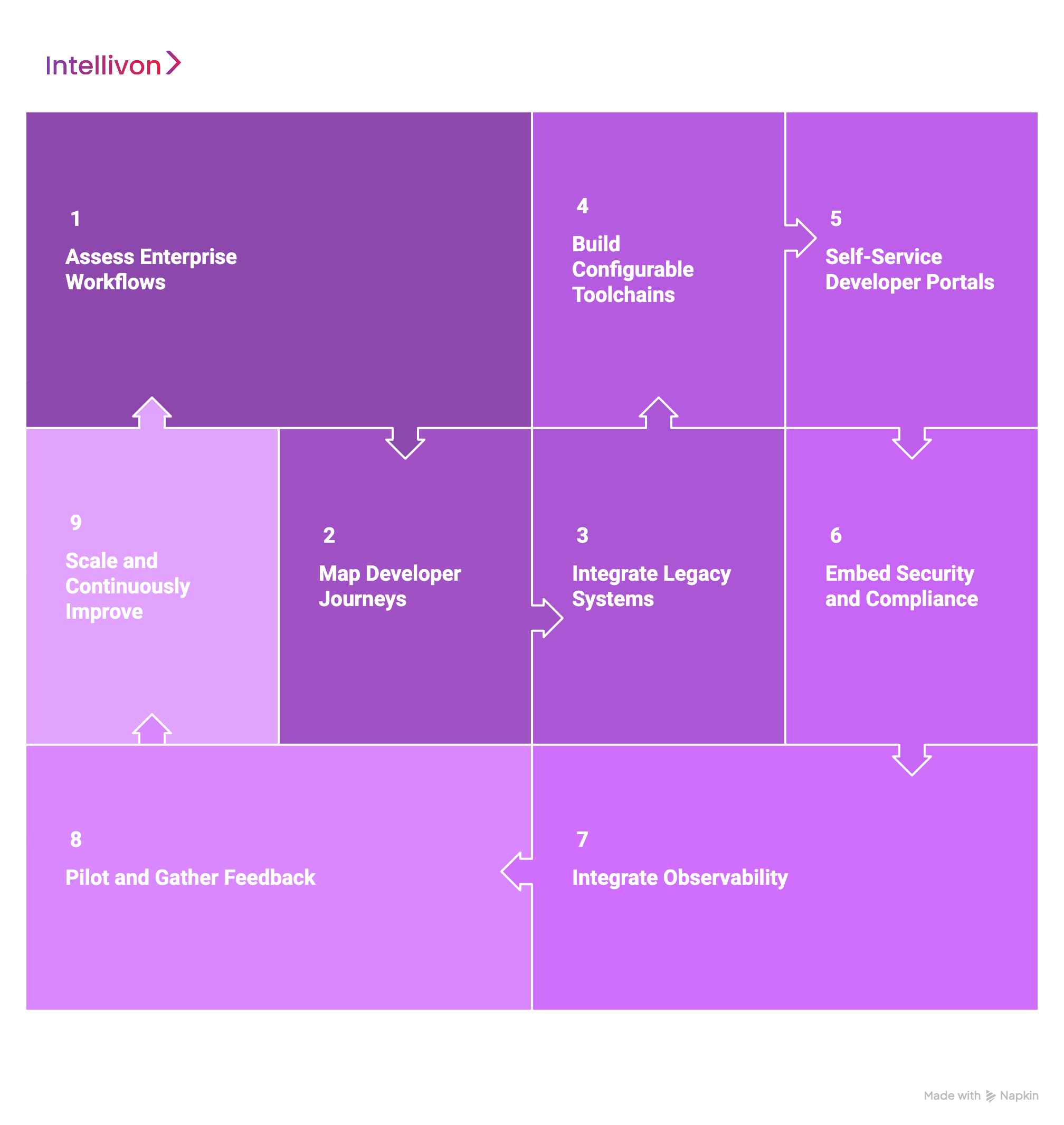 1. Assess Enterprise Workflows
1. Assess Enterprise Workflows
Intellivon begins by analyzing development processes, toolchains, and team structures. CI/CD pipelines, deployment cycles, code review procedures, and collaboration workflows are examined to uncover bottlenecks, inefficiencies, and repetitive low-value tasks that slow developers down.
2. Map Developer Journeys
End-to-end developer journeys are mapped for each role and team. This process highlights critical touchpoints where developers interact with tools, environments, and workflows. The insights reveal opportunities to reduce cognitive load, improve feedback loops, and streamline collaboration.
3. Legacy System Integration
A modular, microservices-based architecture is designed. Each module, including CI/CD, environment provisioning, observability, and security, is fully configurable. Intellivon integrates the platform with legacy systems, ERP solutions, and proprietary tools. This ensures minimal disruption while bridging modern DevEx workflows with existing enterprise infrastructure.
4. Build Configurable Toolchains
Toolchains are designed to be flexible yet standardized. Developers can choose IDEs, testing frameworks, and deployment methods that suit their workflows while remaining compliant with enterprise standards. This balance of autonomy and compliance ensures smooth adoption across large teams.
5. Self-Service Developer Portals
A centralized portal enables developers to provision environments, deploy code, access shared services, and monitor applications independently. Reducing reliance on centralized DevOps or IT teams accelerates delivery and enhances developer autonomy, particularly in distributed enterprise teams.
6. Embed Security and Compliance
Security and compliance are integrated directly into the platform. Automated security checks, policy enforcement, and compliance validations, including GDPR, ISO, and industry-specific regulations, allow developers to maintain secure practices without friction. This reduces risk while streamlining workflows.
7. Integrate Observability and Feedback Loops
Monitoring, logging, and analytics are embedded to provide real-time insights into performance, errors, and operational health. Fast feedback loops for builds, code reviews, and deployments let developers identify and correct issues quickly, maintain quality, and reduce downtime.
8. Pilot and Gather Feedback
Selected teams participate in pilot deployments to validate usability, workflow efficiency, and developer satisfaction. Feedback from pilots fine-tunes modules, optimizes integrations, and ensures the platform addresses real-world enterprise challenges effectively.
9. Scale and Continuously Improve
Once validated, the platform is rolled out enterprise-wide. Continuous monitoring, iterative improvements, and feedback loops allow the platform to evolve with changing requirements, new tools, and team growth. Metrics such as DORA, workflow analytics, and developer satisfaction scores track DevEx improvements over time.
Through this structured approach, Intellivon delivers a secure, integrated, and customizable DevEx Platform that enhances productivity, reduces friction, and drives innovation.
Tools That We Use To Build Successful Developer Experience Platforms
Building a robust DevEx Platform for large enterprises requires a carefully chosen set of tools that enhance productivity, enable automation, and support collaboration across distributed teams. At Intellivon, we leverage modern development, DevOps, and observability tools to create a seamless, integrated platform tailored to enterprise needs.
1. Version Control and Code Collaboration
Platforms like GitHub Enterprise, GitLab, and Bitbucket provide centralized version control, collaborative code review, and workflow automation. They help teams manage large-scale repositories, track changes efficiently, and maintain code quality across multiple projects. Centralizing code collaboration ensures consistency and reduces errors.
2. CI/CD Tools
Tools such as Jenkins, CircleCI, GitHub Actions, and GitLab CI automate build, test, and deployment processes. Automation reduces manual errors, accelerates delivery cycles, and provides faster feedback loops. Developers can focus on coding while enjoying more reliable releases and smoother workflows.
3. IaC and Cloud Management
Platforms like Terraform, AWS CloudFormation, and Ansible automate infrastructure provisioning and management. Standardized environments can be spun up quickly, minimizing setup time and reducing cognitive load. Consistent infrastructure ensures developers can work efficiently across different stages of the software lifecycle.
4. Containerization and Orchestration
Docker, Kubernetes, and OpenShift ensure applications run consistently across environments. Orchestration tools manage scaling, deployment, and monitoring of complex microservices. Together, these tools allow large teams to handle enterprise-level workloads without friction.
5. Monitoring and Observability Tools
Tools such as Prometheus, Grafana, Datadog, and New Relic provide real-time metrics, logs, and traces. They help developers detect performance bottlenecks, monitor deployments, and troubleshoot issues proactively. Observability is critical for maintaining high-quality, reliable software in enterprise systems.
6. Knowledge Sharing Platforms
Platforms like Confluence, Notion, Slack, and Microsoft Teams facilitate communication, documentation, and knowledge sharing. They break down silos, ensure developers have easy access to resources, and promote team alignment, which is especially important in large, distributed teams.
7. Testing and QA Tools
Automated testing frameworks such as Selenium, JUnit, Postman, and SonarQube ensure code quality, reduce defects, and accelerate feedback loops. Integrating QA tools with CI/CD pipelines gives developers instant insights into issues, allowing for faster resolution and more reliable deployments.
8. Security and Compliance Tools
Tools like HashiCorp Vault, Snyk, Aqua Security, and Checkmarx embed security and compliance directly into the DevEx platform. Automated vulnerability scanning, secret management, and compliance checks enable developers to maintain secure workflows without added friction, reducing enterprise risk.
9. Developer Feedback Tools
Platforms such as Worklytics, LinearB, and Jira Analytics track workflow efficiency, developer velocity, and DORA metrics. They provide actionable insights into bottlenecks, team performance, and areas needing improvement, helping enterprises optimize DevEx continuously.
10. Custom Modules and APIs
Intellivon develops custom APIs and platform modules to integrate legacy systems, automate repetitive tasks, and provide specialized functionality for specific teams or organizational needs. These customizations ensure the DevEx platform aligns perfectly with enterprise requirements.
By combining industry-standard DevOps tools, collaboration platforms, observability solutions, security frameworks, and custom modules, Intellivon builds highly integrated and scalable DevEx Platforms.
Future of DevEx in Enterprise Teams
The landscape of software development in large enterprises is evolving rapidly. Businesses face growing demands for faster innovation, stronger security, and greater scalability. In this environment, DevEx will play a central role in shaping how enterprise development teams operate and deliver value. Here’s what the future holds:
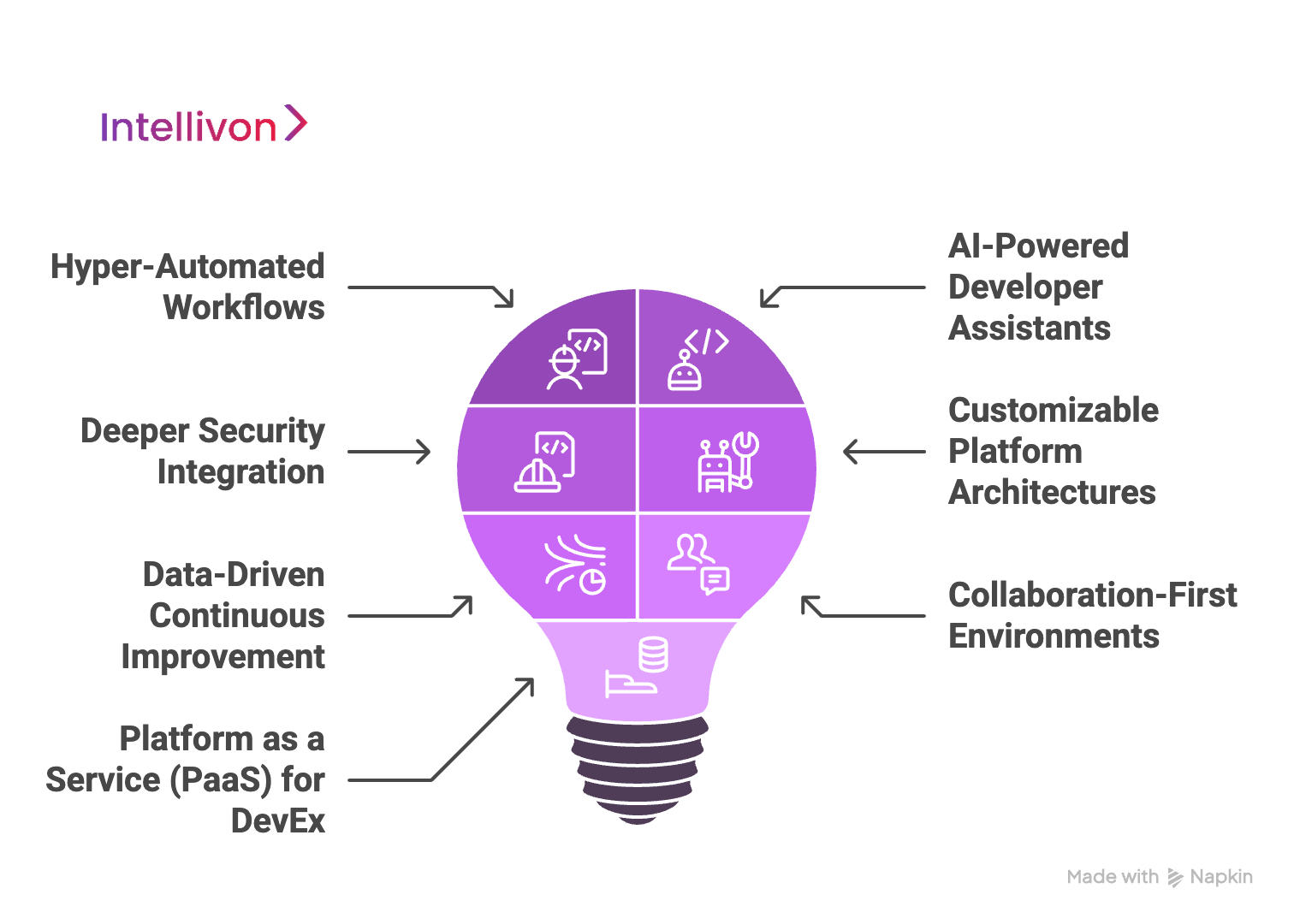
1. Hyper-Automated Workflows
Automation will expand beyond CI/CD pipelines into broader aspects of the developer lifecycle. Intelligent automation will handle environment provisioning, compliance validation, code generation, and performance optimization. Developers can focus entirely on solving business problems while repetitive tasks are managed automatically.
2. AI-Powered Developer Assistants
AI-driven tools will provide contextual recommendations, detect potential bugs in real time, suggest code improvements, and automate routine tasks. These intelligent assistants reduce cognitive load, accelerate development, and enhance code quality without requiring manual intervention.
3. Deeper Security Integration
As regulations become stricter, enterprises will adopt platforms that embed security and compliance into every step of development. Next-generation DevEx platforms will offer automated checks, secure coding guidance, and compliance validation in real time, ensuring speed and security coexist seamlessly.
4. Customizable Platform Architectures
The one-size-fits-all approach will fade. Enterprises will adopt modular platforms that allow them to plug in only the tools and modules they need. Whether it’s observability, language support, or compliance features, modularity ensures rapid adaptation to evolving business goals.
5. Data-Driven Continuous Improvement
Advanced analytics will provide deep insights into every aspect of developer workflows. Continuous measurement of cycle times, defect rates, and satisfaction scores will enable enterprises to refine tools, processes, and policies in real time, fostering ongoing DevEx improvement.
6. Collaboration-First Environments
Future platforms will prioritize collaboration for globally distributed teams. Real-time shared coding environments, integrated documentation, and seamless cross-team communication will reduce silos, accelerate innovation, and improve team alignment.
7. Platform as a Service (PaaS) for DevEx
The future will shift toward offering DevEx as a fully managed Platform-as-a-Service. Enterprises will rely on centralized platforms that deliver security, scalability, and customization out of the box, eliminating the need to manage individual tools or integrations.
As companies strive to accelerate software delivery without sacrificing quality or compliance, DevEx platforms will become a strategic backbone of innovation. Intellivon’s platform is built for this future, which is scalable, flexible, secure, and ready to evolve as enterprises grow.
Conclusion
A strong DevEx platform is essential for large enterprises. By focusing on automation, seamless integration, security, and developer independence, companies can reduce friction, speed up innovation, and improve software quality.
As DevEx continues to evolve, organizations that invest in customizable, data-driven, and scalable platforms will empower their developers, promote collaboration, and gain an advantage in delivering important applications more quickly and securely.
Build a Future-Ready DevEx Platform for Your Enterprise
Empowering development teams is about removing friction, improving collaboration, and enabling faster, secure software delivery. With deep expertise in enterprise-grade platform development and a track record of integrating complex systems, we help large enterprises build customizable, scalable, and secure Developer Experience Platforms that drive innovation and productivity.
Why Choose Our Custom DevEx Platform?
- Tailored Workflows: Designed to fit your unique development processes, team structures, and compliance needs.
- Seamless Legacy Integration: Connects effortlessly with ERP systems, proprietary tools, and existing infrastructure.
- Built-In Security & Compliance: Automated policies ensure adherence to industry standards without slowing development.
- Data-Driven Insights: Real-time analytics and feedback loops enable continuous improvement and informed decisions.
- Developer Autonomy & Collaboration: Self-service portals and integrated knowledge-sharing tools boost team efficiency.
Our platform experts are ready to help you:
- Map developer journeys and reduce workflow friction
- Build scalable, modular toolchains with industry integrations
- Implement automated security, compliance, and monitoring
- Continuously optimize the platform based on real-world metrics
Book your free strategy call today and empower your developers with the intelligent, secure, and customizable DevEx platform your enterprise needs.

FAQ’s
Q1. What is a Developer Experience (DevEx) platform?
A1. A Developer Experience (DevEx) platform is a customizable, integrated system designed to streamline development workflows, automate repetitive tasks, provide real-time insights, and embed security and compliance. It helps large enterprises reduce friction, accelerate software delivery, and improve developer productivity by offering self-service tools, modular integrations, and automated monitoring.
Q2. Why do large enterprises need a custom DevEx platform?
A2. Large enterprises face complex development environments with fragmented tools, legacy systems, and strict compliance needs. A custom DevEx platform enables scalable integrations, automates workflows, ensures security, and empowers developers with autonomy. It reduces bottlenecks, improves collaboration, and adapts to evolving business goals, unlike one-size-fits-all solutions that fail to meet specific enterprise requirements.
Q3. How does a DevEx platform integrate with legacy enterprise systems?
A3. A well-designed DevEx platform connects seamlessly with legacy systems such as ERP, CRM, and proprietary tools through APIs and custom modules. This allows enterprises to modernize development workflows without disrupting existing infrastructure. Integration ensures data consistency, smooth information flow, and backward compatibility while enabling new DevEx capabilities like automation and real-time monitoring.
Q4. What role do security and compliance play in a DevEx platform?
A4. Security and compliance are built directly into the DevEx platform, not bolted on. Automated policy enforcement, vulnerability scanning, and compliance checks (e.g., GDPR, ISO standards) are embedded in development workflows. This ensures developers can work securely and efficiently without manual steps, while the enterprise remains protected against risks and aligned with industry regulations.
Q5. How can a DevEx platform improve developer productivity in enterprises?
A5. By automating environment provisioning, CI/CD pipelines, security checks, and monitoring, a DevEx platform significantly reduces cognitive load and repetitive tasks. Self-service portals provide autonomy, while real-time observability and analytics accelerate problem resolution. This enables developers to focus on solving business problems, delivering features faster, and maintaining high-quality code with minimal friction.


